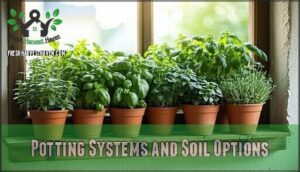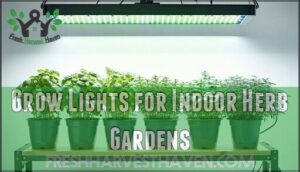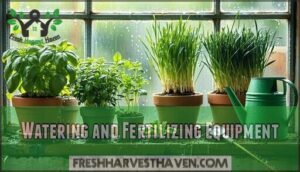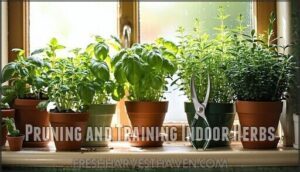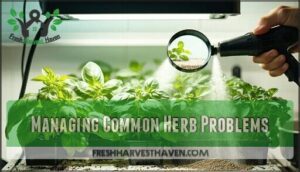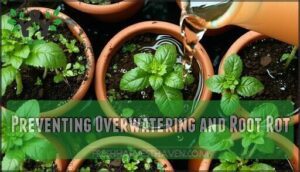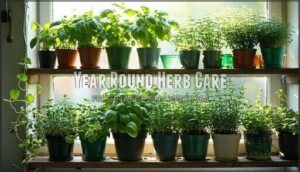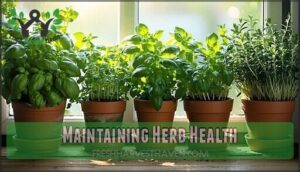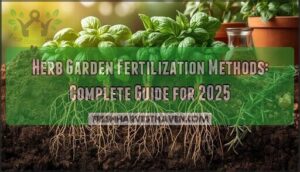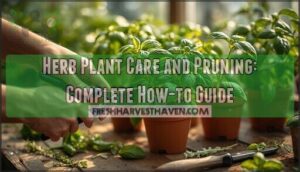This site is supported by our readers. We may earn a commission, at no cost to you, if you purchase through links.
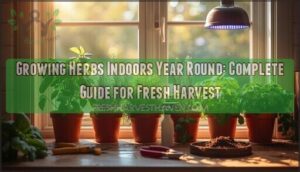
Start by choosing a location with sufficient light, as most herbs require 4-6 hours of direct sunlight.
If that’s not possible, consider using grow lights.
Maintain a consistent temperature between 65-75°F and water carefully to avoid overwatering.
With the right tools and techniques, you’ll be harvesting fresh herbs in no time.
Now, let’s explore the specifics of growing herbs indoors year-round, including tips on pruning, fertilizing, and troubleshooting common issues that may arise in your indoor herb garden.
Table Of Contents
- Key Takeaways
- Choosing Herb Location
- Essential Growing Tools
- Growing Herbs Successfully
- Year Round Herb Care
- Maintaining Herb Health
- Frequently Asked Questions (FAQs)
- Can you grow herbs indoors all year long?
- What herbs can you grow indoors in the winter?
- What herbs should not be grown indoors?
- What is the easiest herb to grow indoors?
- Can basil be grown indoors all year round?
- Can you grow herbs indoors?
- How to decide which herbs to plant indoors?
- Can you grow herbs year-round?
- Where should I put my indoor herb garden?
- What herbs are easiest to grow indoors year round?
- Conclusion
Key Takeaways
- You’ll need to provide your herbs with the right conditions, including sufficient light, temperature control, and water, to grow them indoors year-round.
- Choosing the right location, such as a south-facing window, and using grow lights when necessary, will help you give your herbs the 4-6 hours of direct sunlight they need to thrive.
- To keep your herbs healthy and productive, you’ll need to master techniques like pruning, fertilizing, and troubleshooting common issues, such as overwatering, root rot, and pest management.
- By following these steps and adjusting to seasonal changes, you’ll be able to enjoy a continuous harvest of fresh herbs, and you can grow a variety of herbs indoors, including basil, rosemary, and thyme, with proper care and attention.
Choosing Herb Location
Finding the right spot for your indoor herb garden determines whether your plants thrive or struggle throughout the year.
Choose the perfect spot for your indoor herb garden to ensure thriving plants all year round
Success depends on understanding each herb’s specific light needs, temperature preferences, and space requirements to create an ideal growing environment.
This understanding is crucial for creating a growing environment that supports the health and vitality of your herbs.
Light Requirements for Herbs
When you’re growing herbs indoors, sunlight intensity makes all the difference.
Most herbs need at least six hours of direct sunlight, so window orientation matters—south-facing is ideal.
If natural light falls short, grow light options fill the gap.
Think about light spectrum and light duration, keeping grow lights on for 12 to 16 hours, ensuring consistent, healthy indoor herb gardening.
Low-E windows can help with thermal temperature protection.
Temperature Zones for Optimal Growth
Once you’ve sorted the light, Ideal Temperatures come into play. Most herbs prefer soil between 68–75°F, but you’ll find a few outliers.
Tuning into Microclimates Indoors helps meet unique herb temperature preferences. Yearround herb gardening means keeping an eye on Temperature Monitoring, Zone Hardiness, and Seasonal Adjustments.
To achieve this, consider the following steps:
- Use a digital thermometer
- Avoid cold drafts
- Prevent overheating
- Adjust window placements
- Monitor daily
The growing season is vital, so maintaining proper temperatures helps guarantee successful herb growth and development, as detailed in this guide about weather factors.
Maximizing Space for Herb Gardens
A small indoor herb garden thrives where every inch works hard. Try shelf placement near south-facing windows, mix compact varieties in container gardening, and use vertical gardening or hanging baskets to save space.
For growing herbs indoors year round, smart herb spacing matters. Here’s a comparison:
| Technique | Benefit |
|---|---|
| Vertical Gardening | Saves floor space |
| Hanging Baskets | Sunlight access |
| Container Combinations | Efficient grouping |
| Shelf Placement | Easy organization |
This setup allows for efficient grouping of herbs, making the most of the available space while ensuring each plant receives the necessary care and attention.
Essential Growing Tools
You’ll need more than a sunny windowsill to grow herbs indoors year round, as the right equipment guarantees healthy plants and abundant harvests.
Carefully chosen containers, soil, lighting, and watering tools make each step of indoor gardening successful.
Potting Systems and Soil Options
When growing herbs indoors year round, choosing the right potting materials is key.
Use a potting mix designed for herbs—these offer better drainage, help maintain the right soil pH, and manage nutrient balance.
Remember, container size affects root growth, while drainage holes are a must to avoid waterlogged roots.
Loamy soil is often ideal.
Check your herb soil pH and adjust as needed to ensure better growth.
Grow Lights for Indoor Herb Gardens
After selecting proper containers and soil, you’ll need adequate lighting for your growing herbs indoors.
Most herbs require 6-8 hours of bright light daily. Full-spectrum LED grow lights provide the best light spectrum for indoor herb gardens. Many gardeners source reliable LED options to guarantee maximum growth.
Here are five key grow light considerations:
- LED efficiency – Choose energy-efficient LED grow lights over fluorescent options for better heat management and longer lifespan
- Optimal distance – Position lights 6-12 inches above plants, adjusting as herbs grow taller
- Timer settings – Set automatic timers for 12-14 hours daily to maintain consistent light requirements
- Light spectrum – Full-spectrum LEDs support all growth stages from seedling to harvest
- Heat management – LED grow lights produce less heat than fluorescent, preventing leaf burn in your indoor herb garden
Watering and Fertilizing Equipment
The right watering cans with narrow spouts give you precise control over watering herbs without disturbing delicate roots.
Moisture meters take the guesswork out of watering needs by showing exact soil conditions.
Fertilizer dispensers guarantee consistent nutrient solutions, while automated systems maintain ideal moisture levels.
Many gardeners find success using specialized herb watering methods. Use balanced fertilizer or liquid fish emulsion for steady growth and healthy harvests.
Growing Herbs Successfully
Successfully growing herbs indoors requires mastering three essential techniques that determine whether your plants thrive or struggle.
You’ll need to understand proper pruning methods, recognize early warning signs of common problems, and maintain the delicate balance of moisture that prevents root rot while keeping plants healthy.
This balance is crucial as it prevents root rot while keeping plants healthy.
Pruning and Training Indoor Herbs
Regular pruning keeps indoor herbs productive and healthy throughout the year.
Proper herb pruning techniques prevent leggy growth while encouraging bushiness.
Most herbs respond well to frequent harvesting, which actually promotes new growth rather than weakening plants.
A common issue is insufficient natural light, often remedied with grow lights.
- Pinching Techniques: Remove growing tips with your fingers to encourage side shoots and bushier growth patterns
- Encouraging Bushiness: Cut stems just above leaf nodes where new branches will emerge for fuller plants
- Shaping Herbs: Trim outer stems first, maintaining the plant’s natural form while controlling size
- Removing Flowers: Pinch off flower buds immediately to keep leaves tender and prevent the plant from going to seed
- Supporting Growth: Use clean scissors or pruning shears to make precise cuts that heal quickly without damaging stems
Managing Common Herb Problems
Anyone can face a few bumps on the herb-growing road: spot aphids, spider mites, or whiteflies hiding under leaves during pest identification.
Focus on disease prevention by improving airflow, and manage nutrient deficiencies with a balanced fertilizer.
Check for sunlight problems and adjust your setup as needed, which is part of smart pest management and addressing watering issues quickly to prevent herb diseases.
Preventing Overwatering and Root Rot
Spotting Signs of Overwatering is essential for herb care.
Use pots with Proper Drainage to prevent soggy roots—roots need air, too.
Soil Aeration helps your indoor jungle breathe easy.
If roots look brown or smell odd, you’re Recognizing Root Rot.
Try gentle Fungicide Treatments, check drainage holes, and tweak your herb watering routine for smooth growing herbs indoors and smart herb garden troubleshooting.
Year Round Herb Care
You’re now focusing on year-round herb care, which involves adjusting to seasonal changes and maintaining your herbs’ health.
By following the right techniques, you can enjoy a fresh harvest of your favorite herbs all year round, regardless of the season or weather outside.
Seasonal Variations and Adjustments
Adapting your herb garden through seasonal changes requires strategic adjustments to light cycles, temperature fluctuations, and humidity control.
Winter dormancy affects perennial herbs differently than annuals, with most needing cooler nighttime temperatures around 55-60°F.
Increase artificial lighting to 12-16 hours daily during shorter winter days.
Boost humidity levels using trays or humidifiers to combat dry indoor air, and monitor for increased pest management needs as stressed plants become vulnerable to common indoor pests.
Year Round Harvesting and Maintenance
Your yearround herb garden thrives with proper continuous harvesting techniques that keep plants producing fresh leaves.
Regular pruning prevents herbs from going to seed, extending their lifespan substantially.
- Harvest frequently – Pick leaves weekly to encourage new growth and prevent flowering
- Cut stems properly – Use clean scissors, cutting just above leaf nodes for regeneration
- Monitor for pests – Check weekly for aphids or spider mites during active growth
- Respect dormancy periods – Allow Mediterranean herbs like rosemary to rest in winter months
This consistent herb garden maintenance guarantees your seasonal herb care adapts to each plant’s natural cycles while maximizing herb harvesting throughout the year.
Troubleshooting Common Herb Issues
While maintaining your harvest schedule, watch for yellowing leaves that signal nutrient deficiencies or overwatering problems.
Common herb pests like spider mites and aphids appear as tiny moving dots or sticky residue on leaves. Stunted growth often indicates poor drainage or insufficient light.
Disease prevention starts with proper air circulation and avoiding wet foliage. Quick pest identification and targeted indoor herb solutions keep your garden thriving year-round with proper air circulation.
Maintaining Herb Health
Your herbs need consistent care to thrive indoors throughout the year. Proper watering, soil management, and root health form the foundation for a productive indoor herb garden.
Watering Techniques for Indoor Herbs
Successful watering frequency depends on understanding each herb’s specific moisture needs and environmental conditions. Different herbs require varying amounts of water, making observation essential for indoor herb care.
Here are five essential watering techniques for thriving indoor herbs:
- Check soil moisture by inserting your finger one inch deep into the soil before watering
- Water thoroughly until excess drains from the bottom, ensuring complete root hydration
- Maintain proper humidity levels around 40-50% for most herbs using humidity trays
- Use room temperature water to avoid shocking delicate root systems
- Adjust watering frequency based on seasonal changes and individual herb-specific needs
Drainage importance can’t be overstated – waterlogged soil kills more herbs than drought. Consider using specialized humidity solutions to better manage moisture. Monitor water quality by using filtered water when possible, as chlorinated tap water can stress plants over time.
Soil and Fertilizer Requirements
Once you’ve mastered watering, it’s time to get soil and fertilizer right.
Use loose potting soil with good drainage to prevent soggy roots. Choose organic options or a mild liquid houseplant fertilizer for your herbs’ nutrient needs.
Keep soil moisture steady, watch soil pH, and always follow label rates. Ideal growth relies on the best soil composition.
| Soil pH | Drainage Solutions | Fertilizer Types |
|---|---|---|
| 6–7 | Clay pots | Organic blends |
| 6–7.5 | Perlite added | Liquid feed |
| 5.8–6.5 | Unglazed pots | Plant spikes |
| 6–7 | Compost layer | All-purpose mix |
Promoting Healthy Root Growth
Focusing on healthy roots is key. You can improve root growth with these tips.
- Use well-draining potting soil.
- Incorporate drainage solutions.
- Consider root pruning during repotting.
Remember mycorrhizae benefits. Meet herb nutrient needs with proper fertilization. Adjust watering depth. Soil amendments help.
Root division prevents overcrowding. Good drainage prevents root rot. Your herbs will thank you.
Frequently Asked Questions (FAQs)
Can you grow herbs indoors all year long?
Unlike seasonal outdoor gardens that go dormant, you can cultivate fresh herbs indoors throughout winter and beyond. Most herbs thrive year-round with proper light, drainage, and care.
What herbs can you grow indoors in the winter?
You can grow basil, rosemary, oregano, thyme, parsley, chives, sage, and spearmint indoors during winter. These herbs thrive in south-facing windows with 6-8 hours of bright light daily.
What herbs should not be grown indoors?
You’ll find coriander, dill, and parsley struggle indoors, requiring specific conditions, making them less suitable for indoor gardens due to their unique growing needs and challenges.
What is the easiest herb to grow indoors?
You’ll discover basil is often the easiest herb to grow indoors, thriving in containers with proper sunlight and watering, making it a great choice for beginners.
Can basil be grown indoors all year round?
When the going gets tough, you can grow basil indoors year-round with proper care, including plenty of sunlight and water, making it a great addition to your indoor garden space.
Can you grow herbs indoors?
You can cultivate various herbs indoors, such as basil, rosemary, and thyme, by providing suitable conditions, including adequate sunlight, water, and soil, to thrive year-round.
How to decide which herbs to plant indoors?
You’ll choose herbs based on your culinary needs, climate, and available sunlight, considering factors like growth habits, soil requirements, and moisture levels to guarantee a thriving indoor herb garden.
Can you grow herbs year-round?
You can grow herbs year-round with proper care, including sufficient light, water, and temperature control, allowing for a continuous harvest of fresh herbs in your indoor garden space.
Where should I put my indoor herb garden?
Place your indoor herb garden near a sunny window, ideally south-facing, to provide herbs with 6-8 hours of bright light daily for maximum growth and flavor.
What herbs are easiest to grow indoors year round?
You’ll find basil, mint, and rosemary are top picks for indoor gardens, thriving year-round with proper care and conditions, making them perfect for beginners and seasoned gardeners alike.
Conclusion
You might think growing herbs indoors year round is tricky, but it’s not.
By following these steps, you’ll be harvesting fresh herbs in no time.
You’re now equipped to start growing herbs indoors year round, and with practice, you’ll perfect the art of nurturing your indoor herb garden to enjoy fresh flavors year-round.
- https://bonnieplants.com/gardening/how-to-grow-herbs-indoors/
- https://www.uvm.edu/sites/default/files/Extension-Master-Gardener/Growing_Herbs_Indoors.pdf
- https://larimer.extension.colostate.edu/wp-content/uploads/sites/39/2019/01/Dick-Christensen-herbs.pdf
- https://extension.psu.edu/growing-herbs-indoors
- https://www.aspca.org/pet-care/animal-poison-control/toxic-and-non-toxic-plants/bay-laurel

